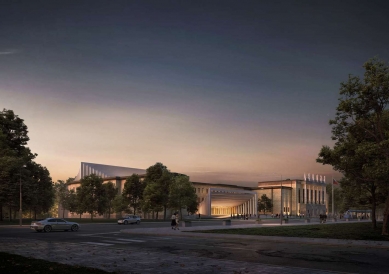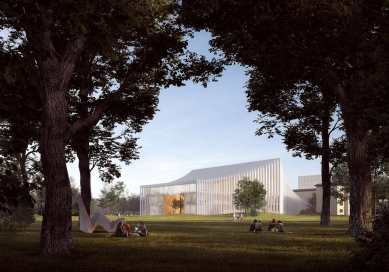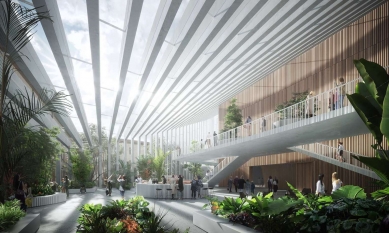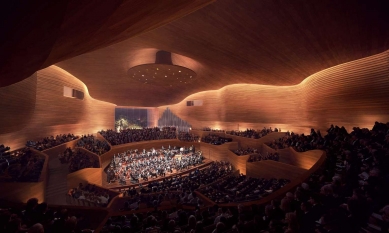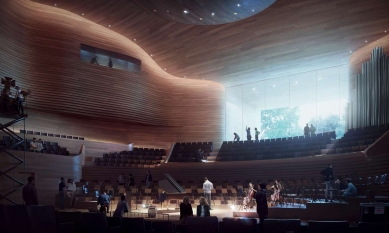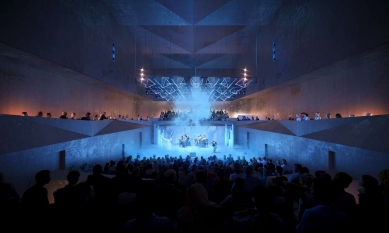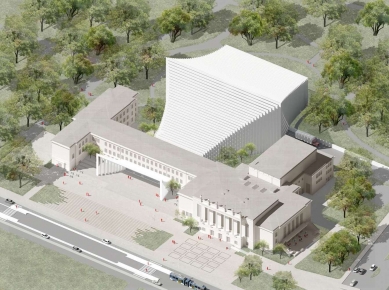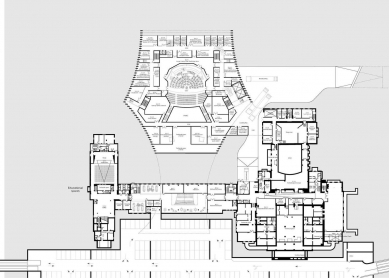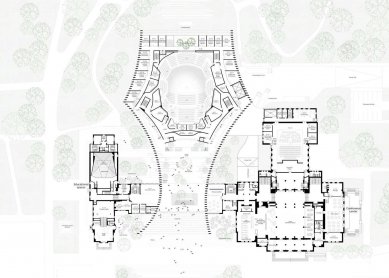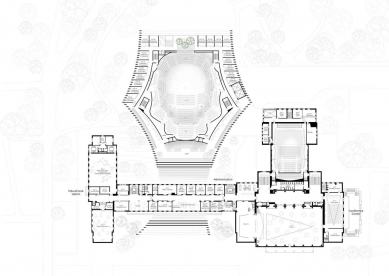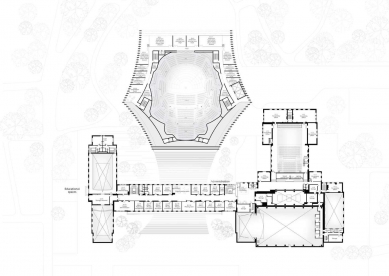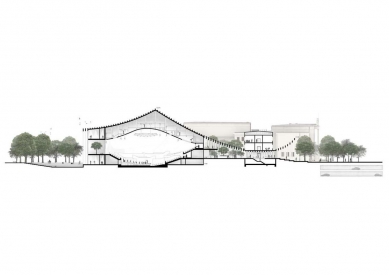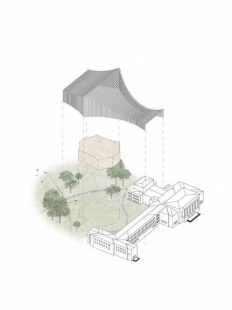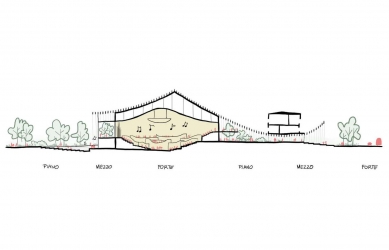
Koncertní hala v Ostravě
2. místo v mezinárodní soutěži

Danish architecture firm Henning Larsen created a new proposal for the Ostrava House of Culture in the Czech Republic. As the the second place winner in an international competition, the project's offset concrete frames set up the form of the new Ostrava Concert Hall as they join together with the existing structure. The design emphasizes openness and connection to the outdoors in the midcentury campus to craft a quiet icon for the city.
Henning Larsen’s design for the new concert hall was made for Ostrava, a small city in the northeast corner of the Czech Republic, in an invited competition set by the city. Announced in August 2018, the competition also invited works from Konior Studio, Architecture Studio, and Steven Holl Architects, who ultimately won the competition. Henning Larsen’s scheme was developed in collaboration with Nagata Acoustics, Buro Happold, and dUCKS Sceno. The project's concrete frame passage, which slowly contracts as it extends backwards into the Hall, invites visitors to step into a passage of light and shadow that casts a pattern of unwritten sheet music on the ground.
“We envisioned the Ostrava Concert Hall as quiet icon, bold enough to open itself fully to the city,” explains Jacob Kurek, Partner and Design Principal at Henning Larsen. “It is a building that is always open, its very architecture welcoming passersby to move through the space as they choose, rather than closing spaces of culture to a rarefied few.” The new concert hall is to be the new home for the Janacek Philharmonic Orchestra and is integrated within an existing campus occupied today by the Ostrava House of Culture and the Sady Dr. Milady Horakove Park.
As the team states, "In stark contrast to the heavy walls of the surrounding House of Culture, the proposed structure blurs the lines between the indoors and outdoors; it is only during evening shows or after opening hours that the connection is limited or closed. This connection to the outdoors is a tribute to the composer Leoš Janáček, a local composer who often found inspiration in the park and for whom the Philharmonic was named. Visitors can slip from inside the building into the park and vice versa, upending a traditional entry sequence (from street to entry to hall and back) in favor of one with no clear beginning or end – it is up to the visitor to choose."
The brise-soleil structure also takes on another meaning: like curtains separating center and backstage, the concrete fins render the interior an extended stage, coupling with daylight to give every visitor their moment in the spotlight. The performance spaces are separated within the building, with the main performance hall occupying the center and two smaller halls situated in the east and west wings. The main hall is organized in the vineyard style, putting musicians at the center of a circular seating configuration. “The plan zips open the underused landscape present on the site today to reveal the full potential of a welcoming cultural house,” Kurek explains. “The openings that allow light to slip into the space during the day also transform the hall into a glowing jewel at night. It is a beacon for the city and signals a new golden age for culture in Ostrava.”
The four shortlisted schemes (from Henning Larsen, Architecture Studio, Konior Studio, and Steven Holl Architects) will be exhibited in the city in September. Construction on the winning scheme is expected to begin in 2022, with a completion date scheduled for 2024.
Henning Larsen’s design for the new concert hall was made for Ostrava, a small city in the northeast corner of the Czech Republic, in an invited competition set by the city. Announced in August 2018, the competition also invited works from Konior Studio, Architecture Studio, and Steven Holl Architects, who ultimately won the competition. Henning Larsen’s scheme was developed in collaboration with Nagata Acoustics, Buro Happold, and dUCKS Sceno. The project's concrete frame passage, which slowly contracts as it extends backwards into the Hall, invites visitors to step into a passage of light and shadow that casts a pattern of unwritten sheet music on the ground.
“We envisioned the Ostrava Concert Hall as quiet icon, bold enough to open itself fully to the city,” explains Jacob Kurek, Partner and Design Principal at Henning Larsen. “It is a building that is always open, its very architecture welcoming passersby to move through the space as they choose, rather than closing spaces of culture to a rarefied few.” The new concert hall is to be the new home for the Janacek Philharmonic Orchestra and is integrated within an existing campus occupied today by the Ostrava House of Culture and the Sady Dr. Milady Horakove Park.
As the team states, "In stark contrast to the heavy walls of the surrounding House of Culture, the proposed structure blurs the lines between the indoors and outdoors; it is only during evening shows or after opening hours that the connection is limited or closed. This connection to the outdoors is a tribute to the composer Leoš Janáček, a local composer who often found inspiration in the park and for whom the Philharmonic was named. Visitors can slip from inside the building into the park and vice versa, upending a traditional entry sequence (from street to entry to hall and back) in favor of one with no clear beginning or end – it is up to the visitor to choose."
The brise-soleil structure also takes on another meaning: like curtains separating center and backstage, the concrete fins render the interior an extended stage, coupling with daylight to give every visitor their moment in the spotlight. The performance spaces are separated within the building, with the main performance hall occupying the center and two smaller halls situated in the east and west wings. The main hall is organized in the vineyard style, putting musicians at the center of a circular seating configuration. “The plan zips open the underused landscape present on the site today to reveal the full potential of a welcoming cultural house,” Kurek explains. “The openings that allow light to slip into the space during the day also transform the hall into a glowing jewel at night. It is a beacon for the city and signals a new golden age for culture in Ostrava.”
The four shortlisted schemes (from Henning Larsen, Architecture Studio, Konior Studio, and Steven Holl Architects) will be exhibited in the city in September. Construction on the winning scheme is expected to begin in 2022, with a completion date scheduled for 2024.
Henning Larsen Architects
0 komentářů
přidat komentář



